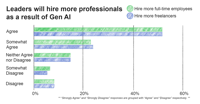The rise in Generative AI has made it easier to produce more content in less time and with less effort. So, will AI usurp copywriters? Are these writing robots coming for me and other content marketers?Â
What if I told you that generative AI has actually increased demand for human writers?
But donât take my word for it; Iâm just a lilâ olâ human writer. According to a job trends report from Freelancer.com, creative writing was the fastest-growing freelance job in 2023. In just the second quarter, creative writing jobs increased by 58%, followed by copy typing and ghostwriting.Â
Last year, Upwork surveyed 1,400 US business leaders to get their opinions on generative AI. 49% said they would hire more freelancers due to generative AI, and 64% of C-suite respondents agreed that they would hire more professionals of all types because of generative AI.Â
Original graph credit goes to the amazing Dr. Kelly Monahan, Managing Director of the Upwork Research Institute.
What is happening here? Why is generative AI fostering demand for humans?
If you have ever used generative AI for a writing project, you probably already know the answer. ChatGPT only gets you so far.
Some companies are turning to humans as a reaction to generative AI. As Matt Barrie, CEO of Freelancer.com, explained in an interview with CNBC News, “AI can’t replace creativity…”
Others are turning to human writers because of AI. Yoav Hornung, head of verticals and innovation at Fiverr, notes that AI-related writing services saw an 80% increase in Q2 of 2023. He also reported a rise in general writing services.Â
This coincides with my own experience. In recent months, clients have hired me to edit, fact-check, proofread and insert their brandâs voice into AI-generated content.Â
How Can Humans and AI Writers Play Nice?
In the general discourse, it can feel like humans vs. artificial intelligence –Â us vs. them. Donât get me wrong; certain individuals explicitly want to replace their workforce with AI applications to avoid paying labor costs. However, for the most part, generative AI has emerged as a tool to augment our work.Â
âAI is not going to replace you. Someone utilizing AI to do more with less WILL replace you.â’Â -Â Unknown.Â
Writers like me are learning the ins and outs of generative AI applications so we can use them to our advantage. For example, ChatGPT is very good for brainstorming.Â
Need to write 60 LinkedIn posts for a client? Letâs devise as many topic ideas as we can. When we get stuck, we can bounce ideas off ChatGPT.Â
I personally really enjoy Perplexity.ai as a research tool. It cites its sources and says, “I donât know” when it canât find relevant information â perfect for jumpstarting my research.Â
Need to close your knowledge gap to hit this case study out of the park? Ask Perplexity some of your particular questions.
SEO is paramount to content marketing, and there are a plethora of AI tools to help. For large marketing agencies, it makes sense to have an SEO expert doing that research. For smaller agencies or individuals, a program like Semrush can streamline SEO research.Â
Need to double-check your SEO? Use Semrush to score your work.Â
Ideally, AI tools would help us streamline menial, repetitive tasks so we can focus on creative problem-solving.Â
What if this is just the beginning? What if AI gets better? What happens when AI can replicate human intelligence?
Generative AI has major drawbacks. It canât incorporate feedback or critiques like we do. It struggles with brand voice. It overuses cohesive devices, creating wordy and verbose language. (To be honest, some writers struggle with that as well.)Â
However, one of its biggest drawbacks is its tendency to hallucinate, that is, make inaccurate information and present it as fact.Â
AI developers are promising continuous improvements. Surely, with enough time, data and effort, they can take AI from 80% correct to 100% accurate. Remember, they are trying to sell a product and acquire investments.Â
Are those promises realistic? Could AI replace a person â creativity and all?
Many AI experts and computer scientists agree that AI (in its current form) cannot achieve human-level intelligence. And that flaw is ingrained in large language models (LLMs) as a whole.
âAll large language models, by the very nature of their architecture, are inherently and irredeemably unreliable narrators⦠As such, they simply cannot be âfixedâ… [hallucinations are] an inescapable property of how they work.â –Â Grady Booch, a world-renowned software engineer best known for co-developing the Unified Modeling Language, explains to the Washington Post that hallucinations are intrinsic to LLMs.Â
LLMs have no conception of the real world. They cannot comprehend what they are saying. They are basically constantly hallucinating. With a tremendous amount of quality training data, their hallucinations can reliably line up with the real world.Â
In that same Washington Post article, Arvind Narayanan, a computer science professor at Princeton, said, âThe tendency of large language models to generate incorrect information is unlikely to be fixed in the near future.â
But why? Why canât we âfixâ AI to have a human’s creativity, intelligence and problem-solving capabilities?
Researchers from the Universities of Tübingen, Cambridge and Oxford experimented with how training data influences the performance of multimodal models. They found that 1) AI systems exhibit a logarithmic relationship between their performance and the amount of training data used. 2) The need for exponential training data implies that these models are incapable of âzero-shotâ generalization capabilities.Â
“Zero-shot” generalization capabilities would be an AIâs ability to perform tasks without explicit training. Humans already do this. We leverage our knowledge and experiences to problem-solve. We use abstract reasoning and contextual understanding to do things weâve never done before.Â
Iâve never written for a wind energy company. (But I sure would like to!) If a wind farm developer hired me, I could use my experience in solar energy and knowledge of white papers to excel with minimum training. An LLM would need extensive training data on wind energy to write accurately. Yet, there would still be no guarantee against incorrect hallucinations.Â
Secondly, the logarithmic relationship between performance and the amount of training data means that LLMs provide diminishing returns. They start with rapid improvements, but then the rate of improvement continuously slows down. At scale, LLMs need exponentially more data just to make marginal improvements.Â
In fact, the top AI developers are already experiencing a âdata shortage.â It is estimated that OpenAI used 12 trillion tokens (units of training data) to train ChatGPT-4. If OpenAI wants to continue its current growth trajectory with ChatGPT-5, it would need 60 trillion to 100 trillion tokens. For context, that is more data than the entire internet!
AI developers are trying to innovate the training process so it is more efficient and cost-effective. However, that is a topic for another article.Â
Where do we go from here? What can businesses do to make the most out of AI in content marketing?
So, AI in its current form will never be as good as a human. But how can businesses make the most out of AI? Hereâs my recommendation: Hire a writer to make the most out of AI for you.
Yes, I know Iâm a little biased, but hear me out. AI is a volatile landscape with many pitfalls to avoid. If you use AI straight out of the box to create commodity content, youâre hurting your brand in the long run. Taking the time to coerce, guide, edit and fact-check AI outputs will only waste more of your valuable time.Â
Writers like me already have AI efficiently integrated into our workflows. We understand prompt engineering, SEO and long-term content strategy. We understand AIâs drawbacks and make up for them.Â
When you use AI, you change your workload from writing to editing. When you use a writer, you receive all the benefits of AI without the risks, along with all the advantages of a human.Â
If youâre curious about AI and how it affects marketing, letâs connect over email (harberwriter@gmail.com). Iâm looking forward to hearing from you.Â
About Austin Harber
My job is to explain complex things in easy-to-understand ways.Â
I work with B2B tech and SaaS companies to communicate complex solutions through clear, compelling storytelling. I ensure that the content is both technically accurate and compelling. With a technical background and experience on the front lines of system design and installation, I bridge the gap between engineers and business audiences.Â
If youâre trying to sell an innovative but complex solution, Iâm the guy to call for clear, concise, and competent content!
AustinHarber.com
LinkedIn.com/in/austin-harber/



